Isn’t this a great line?
“The floor is a hard, unforgiving taskmaster. But the floor never hits you – you hit the floor.”
Source: Put in the Groundwork

Isn’t this a great line?
“The floor is a hard, unforgiving taskmaster. But the floor never hits you – you hit the floor.”
Source: Put in the Groundwork
I went to a parkour workshop yesterday held at 25 O’Clock Brewing in Urbana—one small bit of the UnConference (a very Urbana thing).
I’ve been interested in parkour for years now. I have included various bits in my own training, and also gone to train with the campus parkour group (the same people who led this workshop) a few times. For various reasons (social timidity, physical timidity, lack of fitness) I haven’t managed to establish a regular practice of training with the campus group. But it doesn’t mean that I’m not interested, so I was glad to learn about this workshop, which seemed like a safe, easy way to get back into it—and was.
We were led in a warmup, followed by some quadrupedal movement: Bear crawls, aka foot-hand crawls, both frontwards and backwards, followed by a move I know by the name “traveling ape,” although there are probably other names for it.
After the QM we went for a very short run to a wonderful object that could perhaps be described as a free-standing wall of old railroad ties locked in a wire cage. It had a flat metal top which together with the cage made it great for practicing cat hangs: The cage provides enough of a toe hold that even people with limited grip strength can hold on long enough to get a good workout.
The next thing we worked on was shoulder rolls. I was particularly glad for this part because I used to be able to do shoulder rolls, but at some point in the last 35 years lost the mix. Starting from a kneeling position, though, I was able to recover my roll. In just 15 minutes of practice I was back up to doing rolls from a squat. From there I’m sure I can work up to rolls from a standing position pretty quickly.
(Actually, the main delay is that for some reason the rolls made me queasy. I don’t remember that from 35 years ago, but yesterday I got queasy after a few minutes rolling, and my stomach didn’t completely settle down for several hours.)
After rolls we did some vaults. We started with the safety vault, which I’d already learned (and have continued to practice, because it’s really handy for things like getting across downed trees while out hiking). Then we proceeded to some initial progressions for the kong vault. I’d always thought of the kong as the most advanced vault, but that’s when it’s used to traverse a gap beyond the thing you’re vaulting. It can also be used like the safety vault as a way to get on top of some object, and that’s what we learned yesterday. With a low-enough wall (waist-high, rather than chest-high), I can already get on top with a kong vault.
Shout-out to restorative exercise specialist Ashley Price who spotted that the parkour workshop was going on and suggested that I attend.
Today I’ve already included a bit of parkour in the day’s activities, adding a bit of QM to my afternoon walk, both foot-hand crawling and a bit of ground kong. (The latter is excellent practice for reminding myself that I need to keep my knees together, something that does not come naturally.)
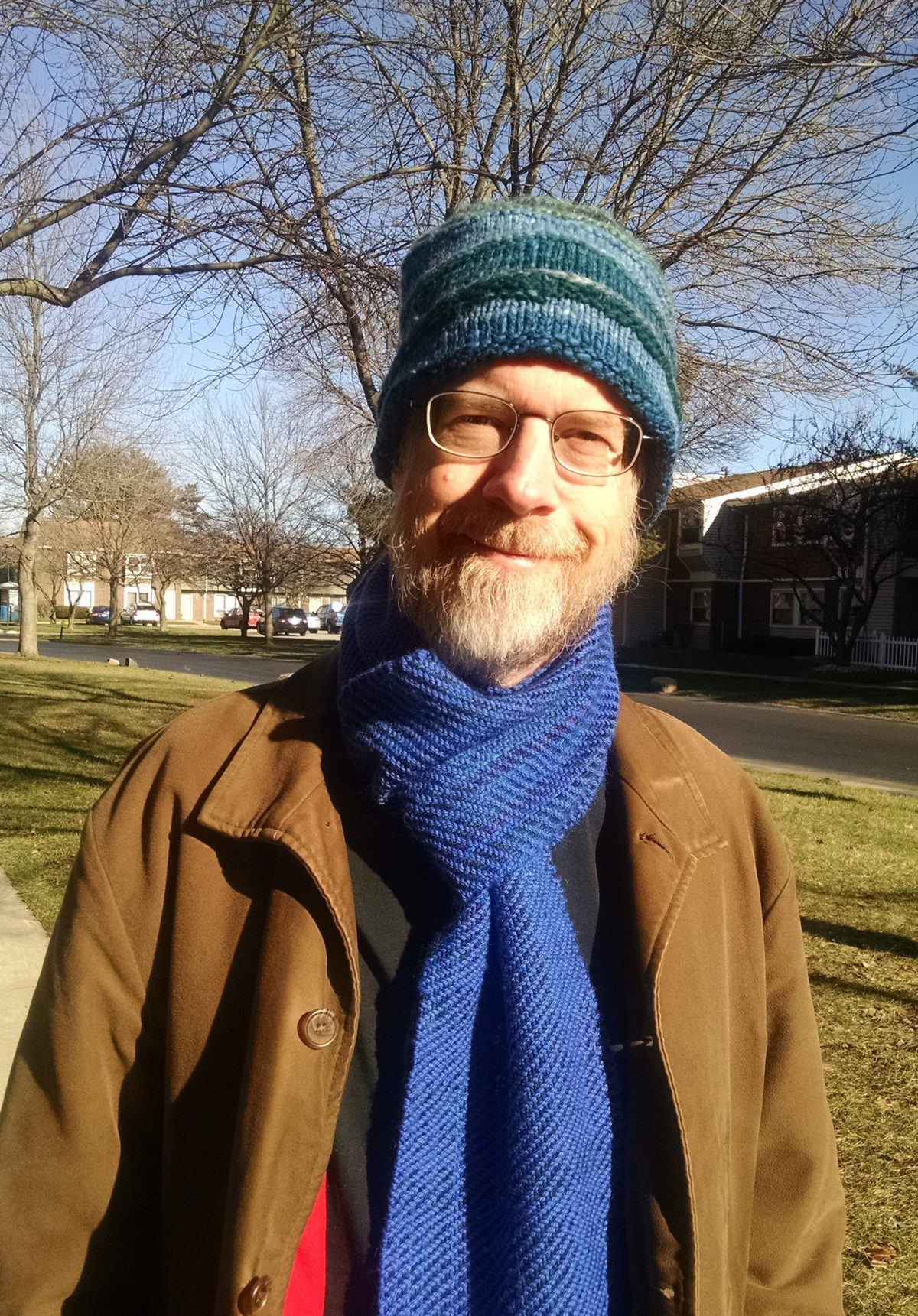
After posting a couple of weeks ago about how I was having trouble adjusting to the cold and dark, I got a comment from Srikanth Perinkulam suggesting that I take a look at What Doesn’t Kill Us by Scott Carney, which I have now done.
The book grabbed me right from the start. The forward by Wim Hof is delightful. The preface sets the stage for the climactic event. In the introduction the author suggests that his spirit animal is a jellyfish—a comforting thought for someone like me whose totemic animal is the sloth.
Because the first few pages were so interesting, I suggested that my brother use Amazon’s “look inside” feature to read them, but he was unwilling to do so—pretending to be daunted by the fact that the “look inside” feature depends on scripts he had turned off in his web browser. He also declared the book to be “pseudoscientific drivel.” (A comment that must have been—since he wouldn’t read even a few pages—based entirely on the subtitle: How Freezing Water, Extreme Altitude, and Environmental Conditioning Will Renew Our Lost Evolutionary Strength.)
Of course it’s not a scientific book, but rather a journalistic one, and my urging was because I thought he would appreciate how well the story was set up—and the jellyfish spirit animal. After all, my brother’s totemic animal is the slug.
The book does talk a good bit about new scientific research into how the body responds to cold and other stresses. Part of the background that is being reported on is emerging evidence that humans have some degree of control over all sorts of autonomic responses, and that one path to gaining that control is by exposing yourself to stresses that trigger those responses, so as to gain an opportunity to practice exerting control.
One area that’s still disputable is how much of that control is real, and how much of of the observable changes are really a matter of “getting your mind right” about the stressor—maybe all of the changes being measured, such as increased mitochondria turning white fat into beige fat (or turning muscle that preferentially burns carbs into muscle that preferentially burns fat), are merely incidental, and the real difference is just deciding that being a little bit cold isn’t so bad.
Since that was, after all, why I was reading the book, that would not be so bad either.
Last winter, when I got off to a better start than I had this year, much of the change in attitude had been prompted by Katy Bowman’s comments pointing out that the actions your body takes in response to cold (vasoconstriction, shivering, activation of the arrector pili muscles) are all movements—movements that, like squatting and crawling, are done all too rarely these days by most people.
The arrector pili muscles in particular intrigue me. Always described as a left-over muscle that helps animals keep warm by making their hairs stand up for extra insulation, it seems like an awfully complex mechanism to have been so well conserved in humans if that’s all it was for. I suspect they have additional uses. Perhaps the calories burned pulling on hair follicles provides a bit of local thermogenesis that can stave off frostbite without the risk to core body temperature that would result if the area were warmed by blood-flow.
Carny talks a bit about vasoconstriction, suggesting that the pain associated with it is due to the fact that it’s such an uncommon movement in most people. If you train yourself for it, he says, it becomes much less uncomfortable.
Carny also has interesting things to say about non-shivering thermogenesis, which is produced by specialized mitochondria that live in brown fat and beige fat (but also apparently in muscle). In particular, he says that the process of converting white fat to beige fat starts with temperature sensing nerves in the skin! I would have assumed that difficulty maintaining core body temperature would have been the initiator, but apparently not: All you need to do is get your skin cold. This means that going for cold-weather runs will do the trick, which has to be the easiest possible way to do it, because your body produces enough heat while running to scarcely feel cold at all.
Thinking about this sort of thing makes it easier for me to get my mind right with winter.
Also helpful is that we’re getting a few days of less-cold weather. It’s still cold enough to provide the necessary circumstances to induce some cold adaptation, but not so cold that I immediately turn up the thermostat and pull out my warmest parka whenever I need to go outside. In fact, I’ve been making a point of dressing slightly less warmly—choosing a jacket one notch down—than I would if comfort were my only criterion.
I expect that by the time full-blown winter weather arrives, I’ll have gotten my mind right.
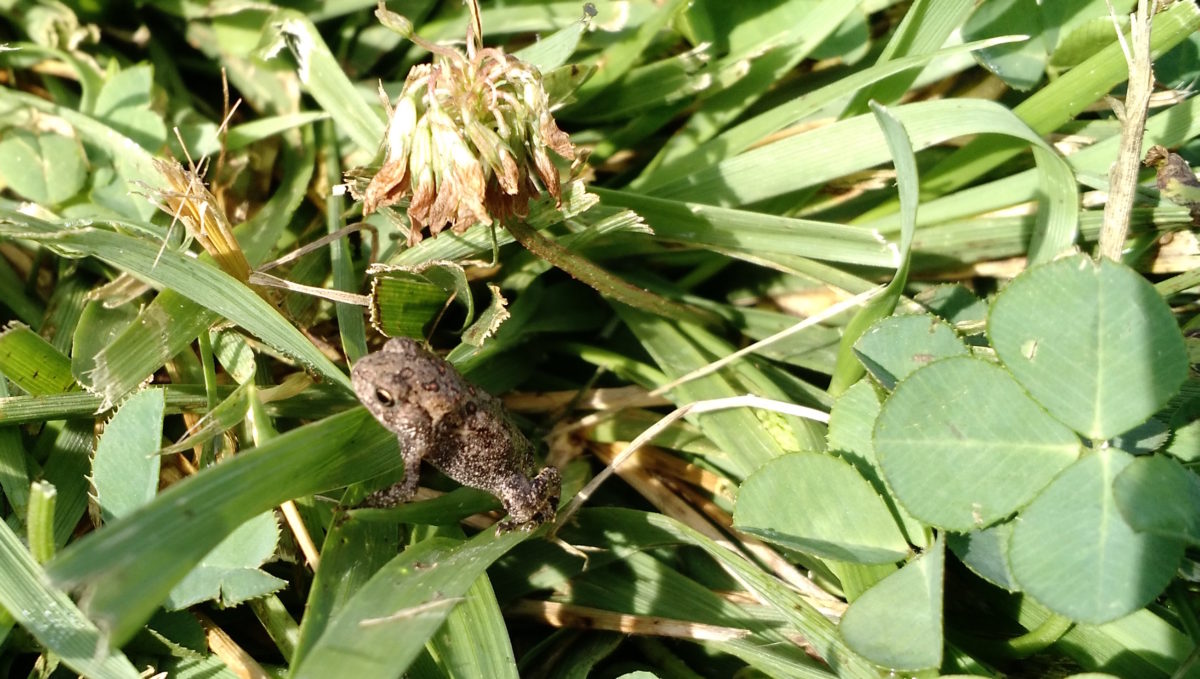
A true fact about me: I’m terrible at watching another person move and then moving in the same way. My coping mechanism for this limitation is that instead of doing what ordinary people do—watching and then doing the same thing—I go through an intermediate step of describing the move in words, and then executing my verbal description.
It’s a slow process. First I have to watch enough times to figure out what the verbal description is, and then I have work through the move very slowly, executing my verbal description while (slowly, and with difficulty) comparing what I’m doing to what I’m supposed to be doing.
Because of all this, I’ve always found it hard to learn things like dance moves and martial arts moves, but it also makes it hard to learn even just ordinary exercise moves.
I mention this, because it has a lot to do with why I’m only now starting to turn up the volume on my exercise: Over the past year, I have added a lot of new exercise moves, drawn from Katy Bowman’s Move Your DNA, from Ben Musholt’s Parkour Strength Training, from Erwan Le Corre’s MovNat videos, and from other sources. For a long time, I’ve felt awkward doing a lot of these moves, and am only now starting to feel like I’m doing them well enough that it’d be safe to start doing them in higher volumes.
One thing that Julie Angel’s book Breaking the Jump reminded me of was that the early parkour practitioners pushed the volume way up in their training, doing hundreds of push-ups, thousands of sit-ups, and covering long distances balancing on a rail (or hanging under a girder, or jumping from rock-to-rock or post-to-post) every day, often multiple times a day.
Of course I can’t do hundreds of push-ups or thousands of sit-ups. What I can do—what I’ve started doing this week—is add sets. I can do 40 meters of quadrupedal movement, and then do another 40 meters later in my training session. I can do 4 negative pull-ups, and then another 4, and then another 3. And so on.
In between sets, I can do the more flexibility oriented restorative exercises. (Right now I’m working on getting the ankle, knee, and hip mobility I need to do deep squats.)
I started upping the volume on the pull-ups and quadrupedal movement a while ago. Now I’m adding some of the newer exercises, such as lunges and squats, that I hadn’t done before, and that felt awkward enough that I wasn’t inclined to add volume.
So far it’s feeling really good.
Oh, and to bring things full circle, it turns out there is an upside to my coping mechanism for my inability to mirror movement—it has made me a better tai chi instructor. When I’m teaching a move, I already have a verbal description of how the move goes. I already have a vocabulary out of which to build descriptions. And I have a lot of practice at producing a verbal description of a movement. These things have turned out to be very helpful.
This was the year that Jackie and I finally managed our long-planned day-hike of the Kal-Haven Trail: 33.4 miles from Kalamazoo to South Haven. It took three years to make the fitness piece and the schedule piece come together close enough to the summer solstice that we could complete the hike in daylight.
That project dominated my movement practice for the year, especially because I was being so careful not to injure myself, out of fear that an otherwise-minor stubbed toe or turned ankle or bruised heel might make the hike impossible, meaning a delay of yet another year.
Another thing that happened is that my taiji teacher asked me to take over teaching his classes. I was already teaching some last year, and since September, I’ve been teaching all of them.
Now at the end of the year, I’ve had another little project: trying to get in 90 minutes of movement every day in December. That started off great: in the first three weeks I only missed 2 days. It rather tapered off in the week of Christmas itself (missed 5 days), but I got back with it this last week to finish the year strong.
I haven’t previously written annual review posts of my movement practice, and it would be pointless to try to create them retroactively. But I did want to trace the key turning points that brought me here. If you’d asked me 8 years ago if I’d be a taiji instructor I’d have dismissed the notion out of hand, and when I’ve tried in the past to remember how I got here, I had trouble remembering. However, I have written plenty of posts on those topics. I’ve used those posts to try to reconstruct my journey from trying to get fit through exercise to simply trying to get plenty of diverse movement.
I’m a bit unsure where to start. I always tried to “get enough exercise,” even before I started thinking through what “enough” would be (and long before I came to think that “exercise” wasn’t the best way to think about it). A few datapoints:
At each of those peaks, I averaged about 100 minutes of exercise per day, which was what I could fit into a week when I had a regular job. (During most of that period, I didn’t tend to count walking as exercise unless I went out for a long hike on trails, an error that I gradually corrected over the next few years.)
I have a rather sad post from April of 2008 in which I lament my failure to take advantage of the extra time I should have had, once I quit working a regular job, because I was spending so much time writing. (I was writing about 5 posts a week for Wise Bread in that period, and also working on a novel.) I resolved to “make exercise–that is, fitness–my number 1 priority.”
In drafting this post, I wrote a long history of my movement practice as documented in my blog here, but I can’t imagine it’s of any interest to anyone but me, so I stuck it off in a text file. Instead, here are the key turning points:
And that brings us up to 2015.
In March I had a practice session with the parkour club at the University. I intended to go back (and still mean to), but haven’t made it yet. This was also around when I first heard about MovNat and natural movement as a thing.
In May I wrote the post that I guess I’ve been groping towards here: Human movement capabilities, talking about my journey from “getting enough exercise” to moving like a wild human.
I expect next year will be a lot like this year. We won’t have a 33.5 mile hike, but I’m sure we’ll have several in the 15–20 mile range. I’ll run. We’ll probably get our bikes out again. I’d like to get back to train with the parkour club again.
Over the winter, I’m planning to work on a few basics.
For the lower body, I want to get to the point where I can comfortably squat—where I can hang out in a squat and do stuff. I want to develop some extra toe flexibility, so I can do the quadrupedal movement thing barefoot.
For the upper body, besides the quadrupedal movement (which turns out to be a really excellent whole-body exercise, as well as being useful), I want to do more hanging. I have no idea how long it will take to get from hanging to pullups, but I’m planning to get it done.
It was interesting to see that my exercise regimen from 2012—the one that prompted me to declare victory—is not actually too different from what I do now. I do five hours of taiji each week, rather than just three. I try to walk 90 minutes every day, rather than 60 minutes just four days a week. I’ve shifted to body-weight exercises instead of weights or machines. (I’ve also gotten a bit lazy about the weights. This winter I’ll step that up.)
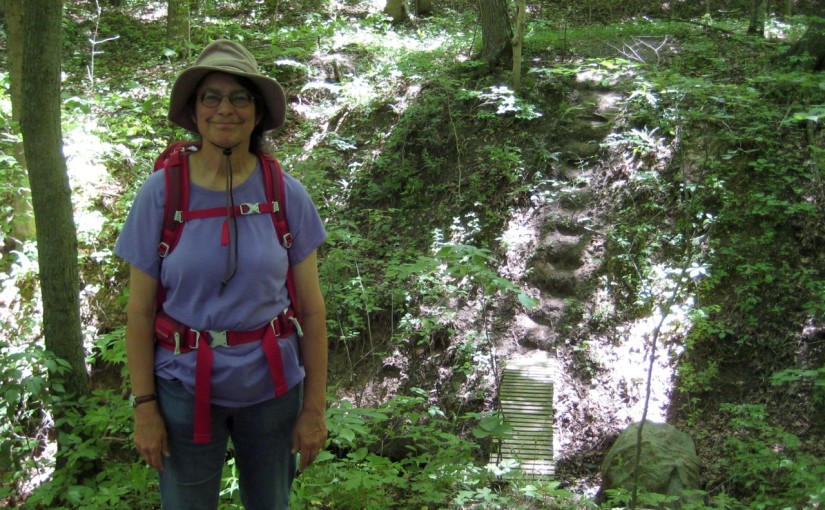
I don’t know when I quit crawling. Probably around first grade. I’m not sure why, either. Because it was something babies did, and I was grown up, I expect.
I don’t remember my parents trying to get me to quit crawling, but I’ve seen other parents try to convince their children to stay off the ground, in the interests of either propriety or cleanliness.
At any rate, most people who crawled all the time before they were five years old have so completely lost the habit it doesn’t even occur to them as a possible way to get under or through something.
When I trained with the local parkour group, the first thing the group practiced was quadrupedal movement—crawling on hands and feet.
After that practice session, I added quadrupedal movement to my own practice, and the first time I went out to do it, Jackie decided to come with me.
(It happened like this: I told Jackie I was going to go play in the woods. “What are you going to do?” she asked. “Crawl and roll on the ground,” I said. “Can I come?”)
We did some rolling, both just rolling sideways and shoulder rolls. We also did some crawling, both prone (bear crawl) and supine (crab crawl).
The actual amount of time spent crawling was pretty small—I doubt if it added up to as much as 5 minutes—but it turned out to be a surprisingly successful bit of practice, because just in the week since then, it has usefully informed the way we dealt with obstacles repeatedly.
The first time was last week at Fox Ridge State Park. At one point the trail was blocked by some fallen trees. There was more than one trunk, making the geometry a bit complex for climbing over. There was enough space underneath the bottom trunk that it would almost have been possible to just do a “step under” move, except we were wearing packs, meaning that we needed another eight or ten inches of clearance.
If I hadn’t just practiced crawling, I don’t think it would have occurred to me that the easiest way to get under the trunks was to crawl on my hands and feet. We’d probably have done something complex, like both take our packs off, have me step under the barrier, handed both packs through (or over), and then have Jackie follow under the barrier.
With the recent reminder that crawling is simple and effective, that’s what we did. I tried to step under, found that there wasn’t clearance for my pack, so crouched down further, put my hands on the ground, and crawled on through. Took about five seconds. Got my hands a little dirty. Worked great.
Yesterday we hiked the backpacking trail at Forest Glen, which presented a problem for which supine crawling made an excellent solution.
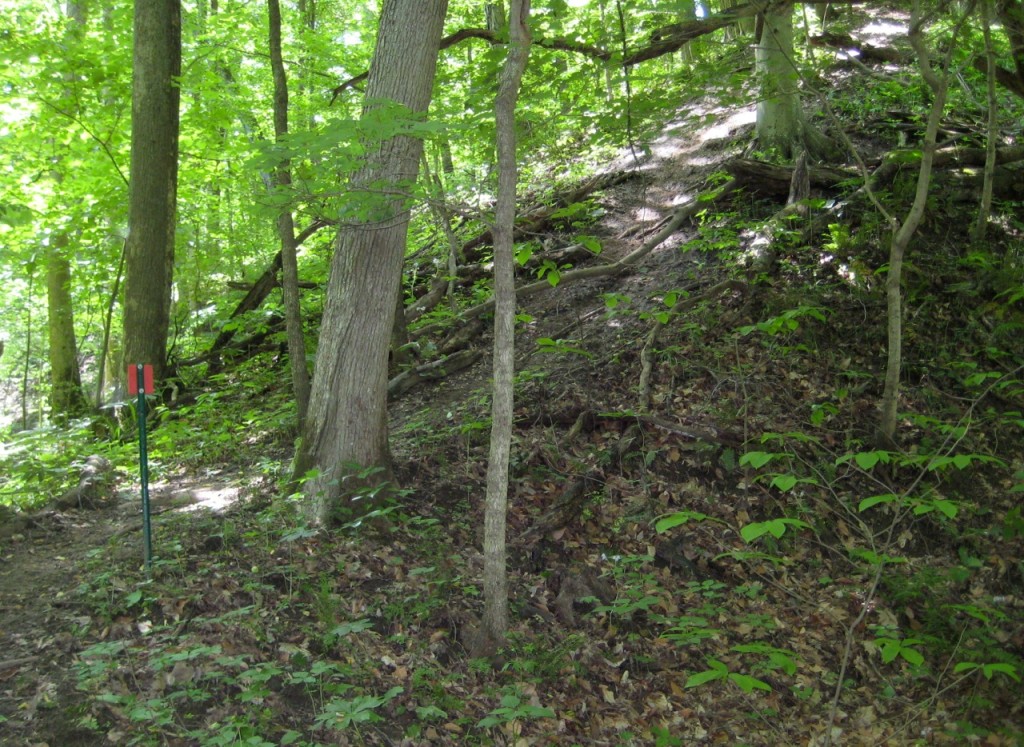 It’s hard to capture the steepness of this bit of trail in a photo. Not only was the trail steep, it was also wet, and the mud was slippery.
It’s hard to capture the steepness of this bit of trail in a photo. Not only was the trail steep, it was also wet, and the mud was slippery.
Jackie went down first, and quickly found that the combination of steep and slippery made it too dangerous to attempt to go down bipedally. She dropped down and did an inverted foot-hand crawl (aka supine crawl or crab crawl). It made for a quick, efficient, safe way down the steep bit in the path.
I followed behind, just the same way.
Rediscover quadrupedal movement. Besides being a way to get under or through something, it’s also very stable—perfect for dealing with loose, rugged, steep, uneven, or slippery ground.
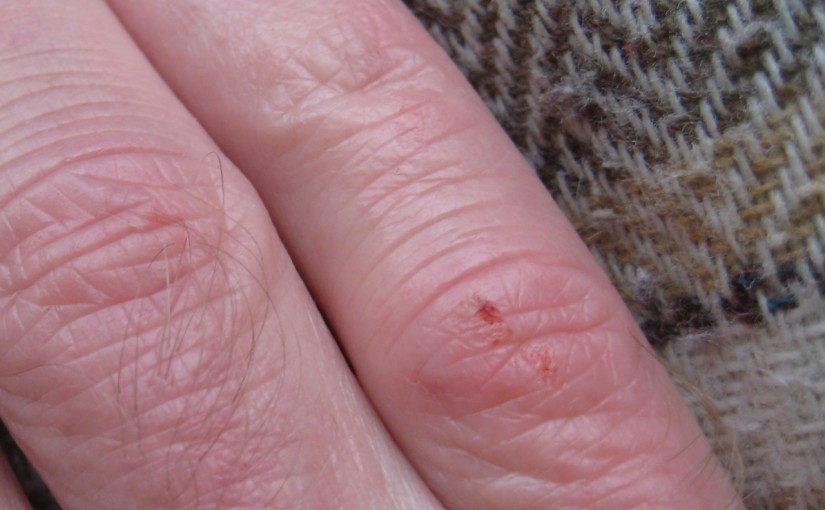
I’ve been following the local University of Illinois parkour club via its facebook page since last year, but what with being busy moving and such last summer, had never gotten out to train with them until today.
I had a great time! We practiced our quadrupedal movement via a game called QM Tag, we practiced our precisions, and they taught me one vault and showed me several others.
They’re a great group—focused on their training but eager to teach me stuff, careful not to push me (or one another) to do things we’re not ready for.
I bowed out early, after a bit over an hour, but except for having skinned my knuckles in the QM Tag, I believe I escaped uninjured. I’ll definitely be back—and I’ll definitely be stepping up my own practice in the meantime. I want to do more.